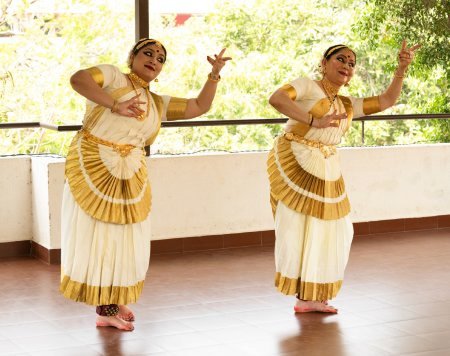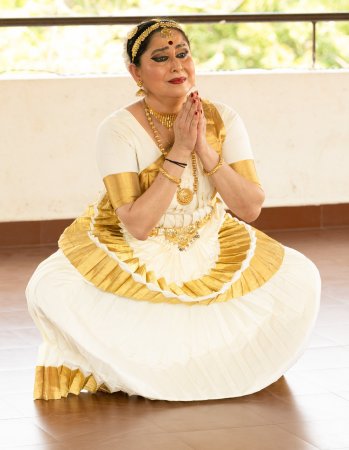
|   |

|   |
When art is written on the body - Anita Vallabh e-mail: anitavallabhofficial@gmail.com Photos: Sujith Kumar February 6, 2025 Over time, as an art form is consistently practiced with unwavering dedication, a certain refinement and maturity gradually permeates its essence. It is an intangible quality, deeply felt in the heart of a discerning audience. It manifests in the artistís speech, demeanor, actions, interactions, and responses. Shalini Shivashankar is one such artist. Celebrated for her proficiency in the Bharatanatyam and Mohiniattam traditions, she is a torchbearer of our cultural heritage in the United Kingdom, where, as the Director of Upahaar Dance School, she has been practicing and training for over 22 years.  Shalini Shivashankar & Piya Varma On January 3, 2025 accompanied by her senior disciple Piya Varma, the duo performed traditional Mohiniattam repertoire at the venue, Arts on Terrace. The two dancers commenced their performance with the graceful movement of a benevolent Ganesha in the Vandana, Varanamukha, set in Rukmambari ragam and choreographed by Nirmala Panicker. This auspicious beginning established a well-paced rhythm for the ensuing performance. It was followed by a well-coordinated Cholkettu in Ragamalika, choreographed by Sreedevi Rajan. The Varnam in Neelambari ragam, composed by Swathi Tirunal, Sarasa Shara Sundara, and choreographed by the inimitable Kalyani Kutty Amma, is a remarkable fusion of poetry, melody, and fluid movement. Musically and lyrically, each word was imbued with the anguish associated with a vipralambha sringara. While individually, Shalini and Piya aptly expressed the torment of separation, the Nayikaís plight and the complex nature of a pining heroine was somewhat diminished when performed together. The subsequent song, Kanakamayam ayidum, is an ideal choice for two dancers. It is an exquisite composition from the Utsava Prabandham literature of Swathi Tirunal, performed in the ragam Huseini. In this song, the two dancers contemplate and question each other about the identity of the deity approaching with all the splendor and riding the magnificent kamala vahanam. This was followed by Lalgudi Jayaramanís Thillana in Desh, choreographed by Shalini and Navarasa Shloka from Soundarya Lahari. I observed the performance, characterized by the swaying of the torso, the angular bends, and the graceful dips into the ara mandala, to be heartwarmingly beautiful.  Shalini Shivashankar On this day, against the backdrop of natural sunlight, warm yellow overhead lights, gentle morning breeze and green plants, Shalini and Piya gave us much-needed respite from the hustle-bustle Margazhi season by drawing us into the essential beauty of slowing down and enjoying the lilting grace of movement and mimesis. Lights were by Arts on Terrace. A note on the venue: Art on Terrace, as the name suggests, is the terrace of dancer Meera Krishnamurtiís residence. It provides an intimate setting that fosters connections between the artist and the audience. The unobstructed viewership and engaging conversations that ensue after the performance allow the community to appreciate the essence of the artistís work. After the performance I asked two foreigners their impression of the performance. With a hand on heart one of them said: peaceful. What more can we ask of the art and the artist?  Anita Vallabh Ph.D, is an Affiliate faculty at the University of Hawaii, author, dancer, Yoga instructor and dance critic. She lives in Boston, USA. |